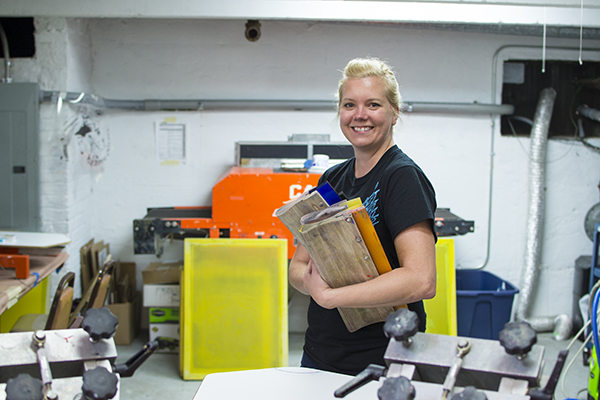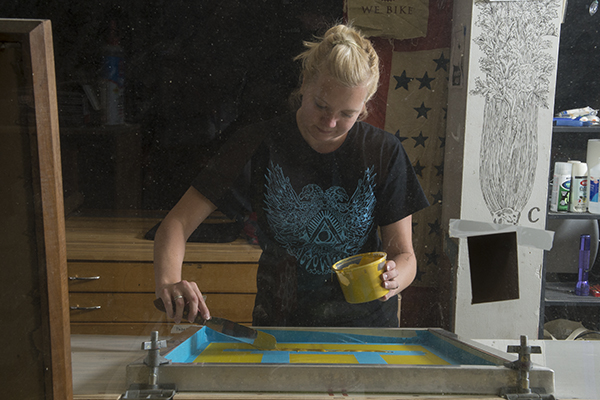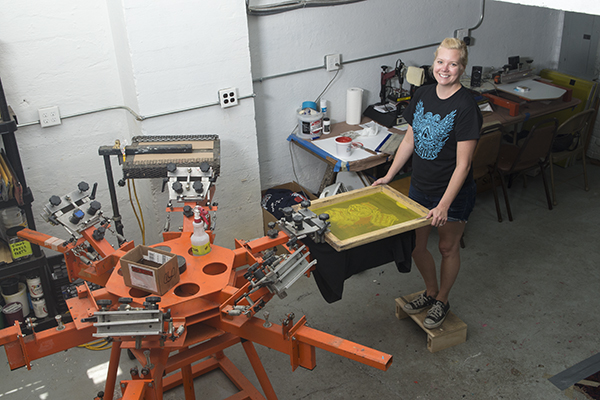Dreams Do Come True: Lauren Mancini and the victory of tenacity
It was nothing short of remarkable when Lauren Mancini stepped onto the stage as Valedictorian of the Art Academy of Cincinnati Class of 2015. Her very presence among the graduating class was the culmination of a steep uphill climb personally and academically, a dream come true.
Like every year before it, the Art Academy of Cincinnati’s Class of 2015 was full of talent, skill and promise. And for all the graduating students, there was reason to celebrate.
When Lauren Mancini stepped onto the stage as Class Valedictorian on May 9, however, it was nothing short of remarkable. In fact, her very presence among the graduating class was the culmination of a steep uphill climb personally and academically.
For Mancini, college graduation was truly a dream come true.
At home but out of place
Lauren Mancini felt out of place in Cincinnati from the very beginning. A Pennsylvanian by birth, her family moved to the area by way of West Virginia when she was 12 years old. The experience, she remembers, was jarring.
“Where I was from in Wheeling (West Virginia), it was so small, if I missed the bus I could walk to school,” she says. “I could ride my bike to the corner market by myself or to the park. I could do whatever I wanted to do just as long as I told my parents what I was doing. Here, I couldn’t be independent.”
In West Chester, the Cincinnati suburb where Mancini’s family landed, she felt like an outsider.
“Everyone in school made fun of me because I talked weird, because I had an Appalachian accent,” she remembers. “It was really just culture shock. It was just so different here from what I was used to. It took me about two years to make friends.”
This experience would have been difficult for any 12-year-old girl. Add to that Mancini’s perpetual academic struggles, and it was a recipe for disaster.
“I didn’t read very well (and) I’m terrible at math,” she says. “So I had to a lot of after-school classes and tutoring. The school thought that I had a disability, and that (label) traveled with me all through (my different) schools, and it was very discouraging.”
Mancini would have graduated from Lakota West High School in 1999, but she dropped out within a few months of completing her senior year. Looking back, she thinks the failure was partially due to her difficulty learning experiences, partially because of relationship and family issues and partially her stubbornness in the face of disappointment. About midway through her senior year, she knew she was going to be short about two classes, and at that point she gave up.
“I just stopped going,” she says.
In Mancini’s memory, the next 10 years are a bit of a blur.
“I try to block it out because it’s so embarrassing,” she says.
She left her parents’ home that summer and spent most of the next decade partying with new friends and working in restaurants. She was functionally homeless — living between her parents’ house, friends’ couches, sleeping in a car and then sometimes back home again.
Mancini got involved in romantic relationship that was abusive and unstable. They hopped from eviction to eviction.
“I was with him for eight years because I couldn’t get away,” she says. “I felt like I was trapped. Then I got pregnant with my daughter, and I thought it would get better. But I couldn’t stand the thought of my daughter witnessing him being violent or even being violent with her. So that was when I left.”
By this point, Mancini had a stable job at a nursing home but was juggling the stress of being a single parent with new child support and custody battles. Then, two days after Christmas, she was let go from her job.
It was 2009, 10 years after she would have graduated from high school, and she was back at her parents’ home with her child in tow.
“It was a really hard transition,” she admits. “The whole situation was really depressing.”
Without even a high school diploma, Mancini knew finding a decent job during a recession was a longshot. So she cashed in her tax return to cover a few month’s living expenses and signed up to take her GED.
First stop: GED
The first big surprise for Mancini was how easily she passed her GED test without any prep classes and without any studying. Walking across the stage to receive her GED gave her a huge ego boost.
“That was a really powerful feeling, to feel like I actually did something,” she says. “And to know that I can actually do this! After seeing my test scores from my GED, I knew I’m not stupid like everyone said I was in elementary school and high school. … That was a really good feeling, and it made me want to continue.”
Years before, Mancini had dreamed of attending art school, but studying art was not an option in her family. Her parents steered her away.
“I always knew that I was an artist and that I wanted to pursue a career in art,” she says.
Within a few weeks, she was enrolled in the graphic design program at the University of Cincinnati’s Blue Ash campus. Now 29, she enrolled on her own without apology, and her parents were supportive.
Mancini spent the next three years completing her associate degree at UC while struggling personally and academically. To survive the day-to-day expenses at home with her daughter, she took loans for living expenses and signed up for both Medicaid and food stamps.
At school, the academic world was unfamiliar and graphic design was relatively new to her. The learning curve was significant. Mancini had been away from school for 10 years and was learning many of these skills for the first time while her peers were proficient on computers and the design software.
“It took me a while to figure out how to (simply) take a test,” she says. “I had major test anxiety through elementary school and high school, but I found that the more I learned the more I was interested in the subject matter. Then I didn’t feel like I was studying.”
The moment it clicked
For the first time in her life, learning was a source of pleasure rather than embarrassment, but it wasn’t enough.
Artistically, Mancini’s first major breakthrough came during an assignment in a rhetorical writing class. The teacher was fired up about the issue of mountaintop removal and the assignment was to write a rhetorical response to the oppression suffered by Appalachian communities impacted by the mining.
Her first draft was terrible, she remembers. But with encouragement from her teacher, she dug deeper and opened a wound to write the next draft of her paper.
With family roots in Pennsylvania and West Virginia, Mancini’s great-grandparents were coal miners and her father had worked at a power plant. So the experiences of poor Appalachians was familiar to her, and she let her feelings of loyalty to the region direct the assignment.
“That fueled my confidence because I could actually be passionate about something again,” she says. “And it had been so long since I’d been passionate about anything. I had to come to terms with exactly what (miners) were talking about because they were talking about me. Once I did that, it was like it clicked.”
She drew on that experience as she developed her skills in other classes, applying her passion for social and political issues to her graphic design work.
Mancini completed her associate degree from UC Blue Ash with a decent GPA and a few student awards under her belt. Most of the awards came as a total surprise, spurred by professors who encouraged her to submit her work in competitions. She remembers the emotional response she had at winning her first award.
“It was a huge shock,” she says. “I thought, ‘This kind of stuff is not supposed to happen to somebody like me.’ I remember sitting with my professor and getting my award and I was just full of tears.”
From Blue Ash to OTR
After tasting achievement, Mancini wasn’t ready to stop. Her dream all along had been to become an artist, and she was set on enrolling at the Art Academy of Cincinnati (AAC). The academic transfer to AAC was relatively easy, but the transition was difficult for her personally and artistically.
Whereas the program at UC had been client-based and technical, the Art Academy assignments were student-directed and open-ended. For Mancini, it was another case of culture shock. Between navigating AAC’s academic culture and her relationships with other students at the small school, she felt out of place at first.
Without someone to tell her exactly what to do for each project, she took a while to get her footing among her peers. But she poured herself into her work, choosing screen printing, alongside graphic design, as her chosen medium. She was tenacious about her craft.
“When class got out after we got a new project, I didn’t leave and go home or go to the bar,” she says. “I stayed and worked.”
Mark Thomas is an associate dean and professor at the Art Academy and served as Mancini’s advisor from the beginning. He saw right away that she could thrive at the school.
“Lauren is driven by her passion for new ideas and how to give form to them,” Thomas says. “She is relentless about pursuing the ideal form for her ideas. She would redo finished designs over and over until she would discover the best solution. She was a leader in all of the classes I had her. Other students kept a close eye on her work to see what she was doing. But, like all successful students, she was always learning from her fellow students.”
Rising to the top of her class wasn’t what Mancini had in mind, so she had no idea what to expect when she was called into Associate Dean Kim Krause’s office one day. She was sick with worry.
Instead of delivering bad news, Krause simply looked at her and said, “Congratulations, you’re Valedictorian.”
She tried to talk him out of it, Mancini says. She was concerned that it wasn’t appropriate because she was a transfer student, because she still didn’t quite belong. But he reassured her, “Oh, no, you are one of us.”
In five years at the Art Academy, Mancini had gone from a high school dropout and unemployed single mother to her class’ Valedictorian. It was, literally, a dream come true.
“I was in shock,” she recalls. “I went back to my studio and cried. I bawled. I thought, ‘I did it. I’m not stupid like everyone thought I was. I can actually do this.’”
What a difference a few years can make
Now, after securing her degree from the AAC, Mancini’s life resembles more of what you’d expect a college graduate’s to look like. Her personal life has leveled out a bit. She’s engaged to be married and looking forward to a future with her daughter and fiance.
Professionally speaking, she is looking for a full-time gig in graphic design, but she’s been working part-time as a print shop manager for Higher Level Art, an artists collective in Cincinnati. She’s also engaged in side projects for fun.
Matthew Dayler, one of the founders of Higher Level Art, was Mancini’s printmaking instructor at the Art Academy. He invited her to join their studio because he was impressed with her hard work and attention to detail and craft. With that combination, he knew she’d fit in with the other artists.
“I trust her in there (and) she just fell right into it,” he says. “She took over where we were lacking with the print shop. And the shop that was a boiler room is now a legitimate screen-printing shop.”
Mancini describes herself as “stubborn and rebellious,“ which is likely what derailed her education in the first place. But it’s also what put her on that stage 15 years later as Valedictorian.
Had she tried to accomplish the same task the first time around, she doesn’t believe it would have turned the same way. The journey through, it appears, was just as important as the destination.
Thomas of the AAC has seen that theme play out in her work and her life.
“She is a positive soul,” he says. “She takes challenges, obstacles and hurdles and turns them into opportunities to pursue unique and creative solutions.”
It’s a skill best learned over time, through life experience, of which Mancini has plenty for a woman of her age.
So even if Mancini hasn’t quite grown out of her stubborn streak, she’s at least grown into herself in a way that turned her stubbornness into tenacity. And tenacity is the fuel that helps dreams come true.

















